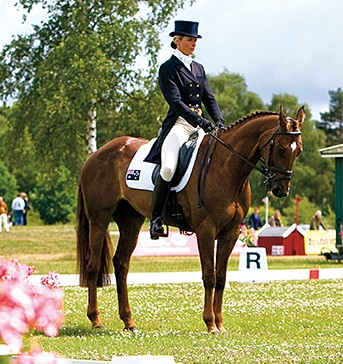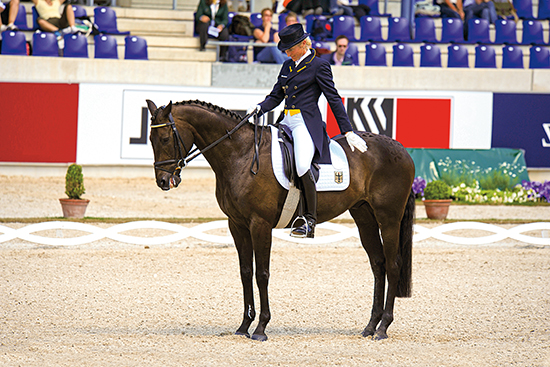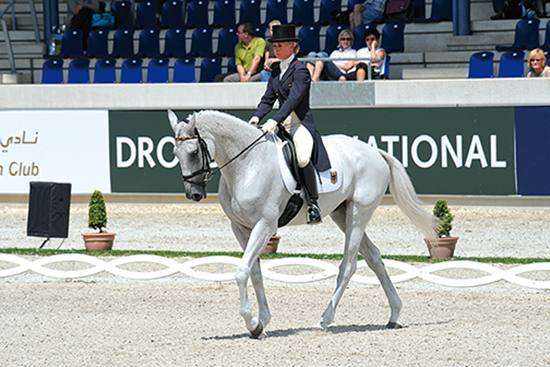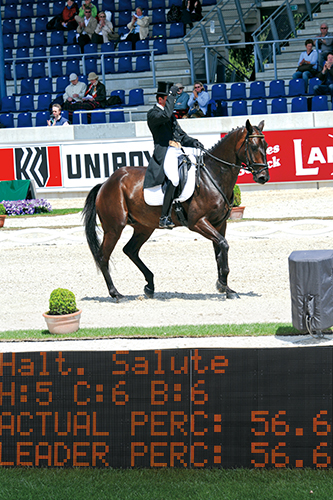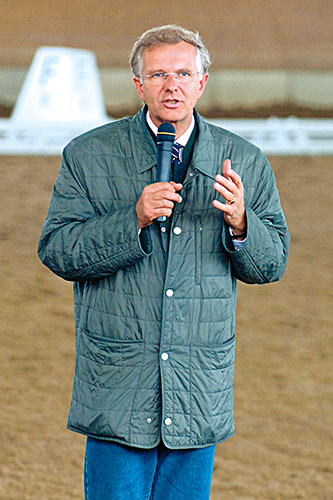 Story by Chris Hector & Photos by Roz Neave and Thomas Ix
Story by Chris Hector & Photos by Roz Neave and Thomas Ix
Christoph Hess is a man of many talents and seemingly inexhaustible enthusiasm and energy. He combines his regular career as the head of the education program run by the German National Equestrian Federation with a career as an international judge in dressage and eventing, and is greatly in demand as the commentator at young horse classes, including the famed Bundeschampionate.
It was great to catch up with Christoph, and get his views on how our eventing riders can get better marks. When we next met him, Christoph had just finished judging at Germany’s top international event – Lumühlen – and as is usually the case with Christoph, he was enthusiastic about the tests he had judged…
“Looking at the 3 star at Lumühlen we had many absolutely world class performances. The tests are getting better and better. I think it was a good idea to bring the flying changes into these tests. About ten years ago, when we started with this project, some riders thought flying changes were too hard, but now the flying change is easy for all these horses. That means we have in the three and four star, more or less no problems with these basic things: simple flying changes, shoulder in and half pass. All the horses are able to produce these movements, but I think a lot of riders lose a lot of good marks during the test with really simple things. A lot of riders don’t have trainers helping them and looking for these very small things. They look to the big things: Is the half pass okay? Is the flying change okay? But they don’t look to the half halts – they don’t look at how they ride a corner – do they ride with the inside leg to the outside rein? It’s all these small things that they don’t have in their focus.”
“In the three star I had at least ten horse and rider combinations that with a little more precision in their riding, they could get at least 10% more good marks. All they needed to do was sit better, and pay attention to these very small things. The horses and the riders are trained in a correct way, but the detailed work is not good enough.”
“What the riders have to think about when they are schooling their horses at home, is picking up those extra marks. Are they schooling in the right tempo? Many riders, especially the Swedish riders, they ride these movements too slow. We have marks for collected paces, but they don’t ride collected paces – they only ride slow trot and slow canter paces, therefore they lose a lot of marks. For instance when they ride serpentines in canter – we have true canter and counter canter – they don’t have a true three beat rhythm, they are very close to a four beat rhythm, therefore they lose good marks, not only in this movement but in the collectives because we give a mark for the paces. When there is a more or less four beat rhythm, then there is no chance to get a mark that is more than six.”
“The second point is that a lot of riders are not able to ride a horse on a curved line: corners, big circles, small circles, what they are doing is use the inside rein and when they use the inside rein to turn the horse, then the horse is crooked, the hindquarters go out, and most of the time the horse’s head is tilted. This is a very very bad preparation for shoulder in and half passes. When they come with a tilted horse into a half pass, then if it was a little tilted on the curved line, by the end of the half pass it is extremely tilted.”
“These are two serious mistakes that come about because the riders are not able to ride with the inside leg to the outside rein.”
“The third point is that the horses have to learn and the riders have to get the right feeling: how to ride half halts and the transition to halt. In the three star B-test, we have three times a halt. Two on the centre line and one after the walk with a rein back. There is a special mark for the halt, and for instance, Ingrid Klimke got three 9s for her halts. You can say you can win a test in halt! Maybe that sounds stupid, but in the end it is true. Other riders get a 3, or a 4 or a 5, because the horses are not well-prepared in the transition, and they are not well schooled to stand in balance on their feet with a good self-carriage. Ingrid is able to produce these good halts every time, and she gets very good marks even though her horse has a trot more like a pony than a true horse. In all the movements, what she achieves is only by training, and she gets the high marks on the simple, small movements. She will never get a 9 for a medium or an extended trot – the highest mark she is able to get here is an 8. But she managed purely through training to turn a 6 in the extended trot into an 8.”
“When Bettina Hoy came in on Ringwood Cockatoo, the first mark I gave her was a 10 – she was absolutely straight, super smooth transition to halt, having the horse in front of her driving aids, then a super balanced uphill halt for 5, 6, 7 seconds, and she was able to greet the judges before she started. In these things, a lot of riders lose good marks. Riders always look, which horse has the best paces? Okay, if you have a superstar with big gaits, this is top but most of the event horses have paces that are just good, from a dressage rider’s point of view, not extremely good. However if the eventing rider is clever with the small things, in the end they will win the class.”
“A super example is Lucinda Fredericks. I judged her when she won at Badminton and this horse has the movement of a pony. Very small trot, normal walk, but in Badminton for all four flying changes, I had a nine! In Lumühlen for the first flying change I had an eight and for all the other flying changes, I had a nine. She rides 100% precise – each corner is a quarter circle, each shoulder in shows good self carriage and good cadence and an uphill tendency. This horse and rider combination is able to show a good collected trot before she starts a movement – for instance, the very first movements, shoulder in, and then half passes, she prepares these movements so well. The others, they come in a very ordinary trot, on the forehand, not with a long moment of suspension, not with cadence, not with suppleness, not with collection, and then they try to get a high mark. The highest they get is a six, while Lucinda with a horse with no great trot, is able to get an eight.”
We also see lots of problems with the rein back, even the horses that score well seem to have difficulties with this movement?
“It’s good to hear you say this because Chris Bartle and I, we made the new tests, I think you can see them on the website of the FEI and I hope on January 1, 2009 we will have these tests in action. It is interesting what you say, because Martin Plewa is in favour of more rein back, maybe schaukel (this is the back and forward and back movement) but I think what we have is enough. For me, what we have is very easy for all horses. It has to be trained correctly from the start, not when the horse is ten years old. You can start with a three and four year old to school it in the stables, without a rider – school the horse to go in a good rein back just on the ground. Later with the rider in the saddle, it will not be a problem. Ingrid and Bettina, in the three star, straight from the rein back and into the canter – 9! The German word is ‘durchlässig’ – supple, straight and with a smooth transition into canter. In the four star, it is rein back and into the walk – which is difficult because rein back is a two beat rhythm and walk is a four beat rhythm, it is difficult for the horse to change the rhythm going backwards and then coming in a correct rhythm forward. This is the challenge to the rider to school the horse, the horse has to be obedient, durchlässig, and then it will work. In the end it is one of the movements that the horse has to learn, and learn well, so that when you go cross country, you have the horse under control. If you can’t do this on the flat, then you can’t control a horse on the cross country course.”
What differences are we going to find in the new tests?
“When I had my last meeting as a member of the Eventing Committee in February 2007, Wayne Roycroft and David O’Connor came to me and said, when you and Christopher Bartle produce a new test, we want to see flying changes every fourth stride on the diagonal. This is now in these new tests. Martin Plewa doesn’t like this movement but I think we had a good talk about it in Lumühlen, and I think the horses are good enough for this. This will be the test for the World Championships in Lexington in 2010, and the 2012 Games. There will be three four times changes on two diagonals. And when Lucinda Fredericks will do this, she will easily get two nines. Clayton Fredericks, from the riders’ association, was also part of the discussion, and I said ‘Clayton, do you know the test?’ and he said, ‘I’ve heard about it but I haven’t seen it’. But Clayton said to me, Christoph, ‘one movement I am not sure about, flying changes every stride or every second stride, I’m not sure they would right test for our eventing horses now, maybe in the future but not now! I said, NO, not ones and twos, four times changes. It is the easiest movement that we have in the Prix St Georges test, every fourth stride. I think with any horse in a good balance, it should work.”
Following the Prix St Georges logic, is the next step a demi-pirouette?
“Maybe some time in the future, but it has not been discussed. We have to find the level to which we can ask the eventing horses in the dressage and showjumping arenas – this was Martin Plewa’s point. The philosophy behind the thinking of Chris Bartle and myself when we framed these tests, was: what is necessary to school a horse in a proper way to go cross country? We don’t do dressage as dressage. Dressage is only a way to ride better cross country, nothing else, then all the movements we include have to pass the test, is it a good movement to go cross country on one-to-four star level? We don’t want to see special ‘circus’ dressage, so I don’t think we will see pirouettes in the foreseeable future. We can have pirouettes in the walk, or turn around the haunches because we have no collected walk, only medium walk, but I don’t think in the near future that we have a proper pirouette… no yet.”
“I think the way eventing dressage has developed is very exciting, the riders are doing most of the ‘hard’ movements very well – if only now they looked at the simple things, then they would go so much better still…”


